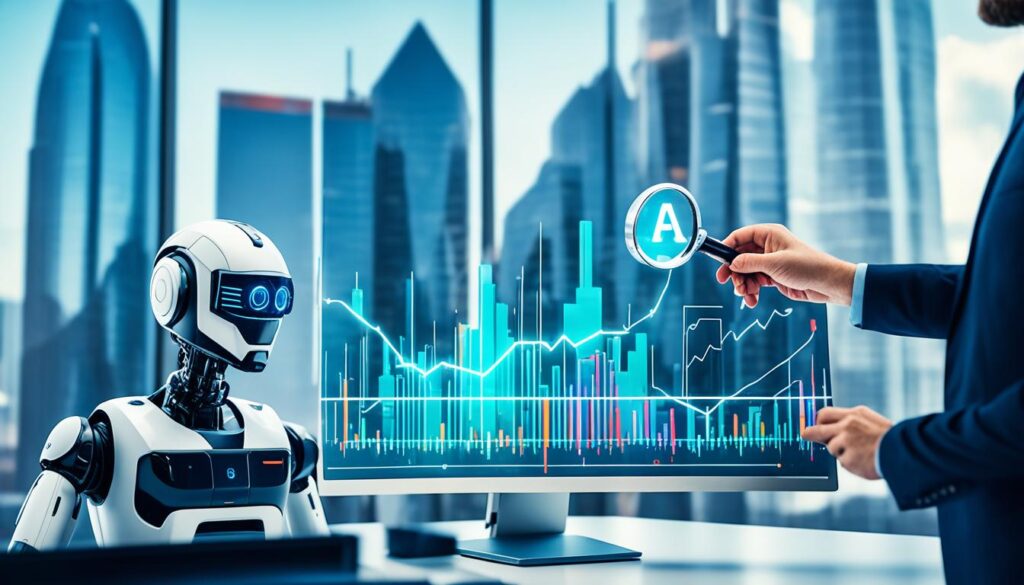In today’s world, data is like the new oil. It’s a key resource that can greatly benefit a business. Yet, only 22% of companies have a strong data strategy. But, the AI revolution is changing how we use data, making it easier to make quick, informed decisions.
Our experts have picked the top 3 AI tools for data analysis. Each tool offers special features to help manage your data better and find important insights.
Key Takeaways
- AI tools for data analysis can change how businesses use and benefit from their data.
- Our experts have found the top 3 AI tools for data analysis, each with unique strengths and features.
- These AI tools can help companies improve their data strategy, make better decisions, and stay ahead.
- By using the right AI tools, companies can make data management easier, automate tasks, and discover valuable insights.
- Exploring AI’s potential in data analysis is key to staying competitive in today’s data-driven world.
The Transformative Power of AI in Data Analysis
AI is changing how businesses and organizations use their data. It uses artificial intelligence, machine learning, and deep learning to find new insights. This helps in areas like understanding language, business intelligence, and predicting trends.
The Rise of AI in Data Analysis
AI has changed data analysis a lot. It makes it easy for more people to use, not just experts. Tools like ChatGPT let users talk to data in a natural way. This has helped industries like medicine and management a lot.
AI can find connections, predict outcomes, and see what will happen next. This is big news for many fields.
Benefits of AI in Data Analytics
- Cost Reduction: Using AI in data analysis can save a lot of money. 54% of businesses say they spend less now.
- Time Efficiency: AI looks at big data way faster than people can. This means quicker and more scalable analytics.
- Enhanced Decision-Making: AI gives better insights for making decisions. This leads to more efficient operations and new ideas.
As more companies use AI in data analysis, they’re ready for a new era. They can make faster, smarter choices that help them succeed.

“The advent of AI in data analysis has been a game-changer, democratizing the process and making it accessible to a broader audience beyond just data scientists.”
AI Analytics: A Threat or an Opportunity?
The world is seeing fast growth in artificial intelligence (AI), and the data analysis field is changing. Some worry that AI will replace human jobs. But, the need for data is growing fast, so AI will likely transform data analyst roles instead. By using AI tools, professionals can move forward in their careers and solve complex problems more efficiently.
AI tools like ChatGPT Plus, Tableau AI, and Power BI are changing how we make decisions with data. They can automate report making, answer questions in natural language, and show data in new ways. These tools help data analysts work better, be more productive, and focus on big-picture strategies.
“AI could help reduce global greenhouse emissions by 1.5% to 4% by 2030, and estimates suggest that 30 percent of human work hours could be entirely automated.”
But, adding AI to data analysis has its challenges. Issues like unequal access to information and how it might change competition are real concerns. Also, AI needs a lot of data, human training, and constant human oversight. This shows we still need human skills in this field.
The future of data analysis is about working together with AI. AI can do some tasks, but humans are still key for understanding context, creativity, and relationships. By using AI’s power, data analysts can focus on big decisions and solving problems, not just worry about the tech.

As data changes, finding a balance between AI and human skills is crucial. This balance lets us use data analysis fully, leading to more innovation, efficiency, and progress in our work and beyond.
Utilizing AI for Data Analysis: A Step-by-Step Guide
Businesses today need to get the most out of their data. AI plays a key role in this by making data analysis easier and more effective. Let’s look at how AI helps in analyzing data step by step.
Data Collection
Gathering different types of data is crucial for good analysis. AI tools can do this automatically, pulling data from websites, CRM systems, and more. This makes sure the data is complete and accurate, leading to better analysis.
Data Cleaning
Preparing data for analysis can be hard and time-consuming. But AI can make it easier. It can spot and remove wrong data, make sure everything is the same, and clean up the data. This lets analysts focus on deeper insights instead of cleaning data.
Data Analysis
AI really shines when finding patterns, connections, and trends in data. It can look through a lot of data fast, finding things humans might miss. This helps businesses understand their market better.
Data Visualization
Turning complex data into visuals is key for making good decisions. AI tools can make dashboards and reports that let users explore the data deeply. This helps in finding important insights.
Predictive Analytics
AI uses past data to predict what might happen in the future. This helps businesses make smart choices ahead of time. It lets them solve problems before they start.
Data-Driven Decision Making
AI’s insights lead to smarter, data-based decisions. Companies can use these insights to improve, find new chances, and tackle challenges. This leads to growth and success.
Using AI in data analysis is becoming more common. Companies that use AI will have a big edge. By following these steps, you can use AI to unlock your data’s full potential. This will help you make better, forward-thinking decisions for your business.
Challenges in AI Data Analysis
AI has changed the way we analyze data, but it’s not without its problems. One big issue is the quality of the data used. If the data is wrong or biased, AI’s insights can be too. This can lead to bad decisions.
Another big challenge is keeping data safe and private. AI needs access to sensitive info, which worries people about their privacy. It’s important to use data safely and ethically, especially in fields like healthcare and finance.
- Challenges in AI data analysis include data quality, data security and privacy, and the need for skilled personnel in data analysis.
- The accuracy of AI analytics depends on the data quality. Bad data means bad insights.
- AI tools use sensitive data, which makes data security and privacy a big concern. We must address these issues for ethical data use.
- Skilled data scientists are key for handling unstructured data and picking the right tools. They help make the most of AI in analysis.
Skilled data scientists are vital for using AI well in data analysis. They know how to deal with complex data and choose the best tools. The challenge is to match AI’s power with human expertise in this fast-changing field.
“The key to unlocking the full potential of AI in data analysis lies in addressing the challenges of data quality, security, and the need for skilled personnel.”
Three Best AI tools for Data Analysis
The field of data analysis is changing fast, thanks to AI. Three AI tools stand out for their power: Polymer, Tableau AI, and MonkeyLearn.
Polymer: Insight Automation for Effortless Visualization
Polymer is a top polymer ai analytics tool that makes data easy to understand and use. It turns complex data into something simple, without needing to code. With ai-driven analysis, it helps you explore data quickly and easily.
Tableau AI: Empowering Data Science Experts
Tableau is famous for its easy-to-use dashboards and flexible visualization. Tableau AI adds a new layer of power for data analysis. It makes preparing data automatic and keeps your data safe with the einstein trust layer.
MonkeyLearn: Unleashing Insights from Unstructured Text Data
MonkeyLearn is great for working with text data. It helps you find important information in unorganized text. This no-coding platform is easy for anyone to use.
| AI Tool | Key Features | Use Cases |
|---|---|---|
| Polymer |
|
|
| Tableau AI |
|
|
| MonkeyLearn |
|
|
“These AI-driven data analysis tools have transformed the way we approach data-driven decision making, empowering professionals across industries to uncover valuable insights with unprecedented ease and efficiency.”
Exploring Other AI Data Analysis Tools
The world of AI-powered data analysis is always changing. New tools have come up to help data analysts and business leaders. Let’s look at three AI data analysis tools that are changing the game.
Jupyter AI: Coding Assistant for Python-Based Analysis
Jupyter AI uses generative AI models to help with data analysis tasks. It works with many Integrated Development Environments (IDEs). Jupyter AI makes python-based analysis easier by supporting various generative model providers.
Qlik: Conversational Analytics with Natural Language Processing
Qlik is a top data analytics platform that’s getting better with artificial intelligence. It has natural language processing for automatic insights and the Insight Advisor Chat for conversational analytics. This makes it easy for users to get insights from their data using natural language.
ChatGPT: Advanced Data Analysis with File Format Support
ChatGPT, a famous conversational assistant, now does more than just chat. It can handle different file types like text, PDFs, and code. This means it can do python-powered execution and code conversion, making data analysis smoother.
“AI-driven data analysis tools have revolutionized the processing and analysis of large volumes of data, empowering data analysts to deliver valuable business insights and gain a competitive edge.”
Tools like Jupyter AI, Qlik, and ChatGPT are changing how businesses use data. They use machine learning, natural language processing, and other AI tech. This helps analysts work better, find deeper insights, and help businesses grow.
Maximizing AI’s Potential in Data Analysis
Businesses and organizations are turning to AI for data analysis more and more. Julius AI is a leading tool that changes how we handle data. It automates tough tasks and gives clear insights, helping users get the most from their data.
Julius AI: Enhancing Data Analysis Efficiency
Julius AI works well with current data systems, boosting their AI power. It makes big, complex data easier to understand with clear visuals and predictions. This makes it a must-have for both new and experienced data analysts.
Julius AI is great at cleaning data automatically. It uses automated insights and customized analysis to find and fix data problems. This ensures the data is reliable and accurate.
With interactive reporting, Julius AI helps users spot patterns and trends in their data. This lets them make smarter, data-based choices.
The Future of AI-Driven Data Analysis
AI in data analysis is here to stay and is changing how we use data. Tools like Julius AI are becoming easier to use, which means we can get insights faster and move towards a data-empowered future.
The future of AI in data analysis is exciting and always changing. AI’s ability to manage huge amounts of data and find hidden links will greatly improve decision-making.
By using AI for data analysis, businesses and people can discover new insights. This leads to a more data-driven and transformative future.
Conclusion
AI is changing how we make decisions with data. Tools like Julius AI make data analysis faster and easier. This helps businesses and people get valuable insights quickly.
These AI tools are getting better and better. The future of data analysis looks very promising. Using AI in data analysis makes our decisions more efficient and accurate. It also opens up new chances for growth and innovation in many fields.
We need to keep up with the latest in AI data analysis tools. Exploring how these technologies can help us is key. By using AI to its full potential, we can make better decisions. This leads us to greater success.



